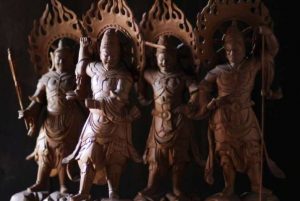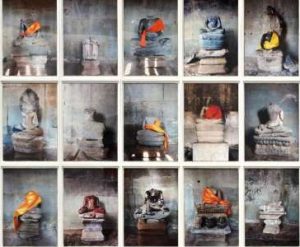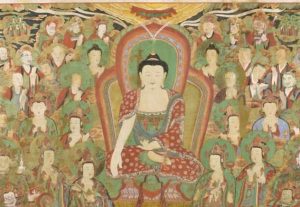
Tsum Valley, in Nepal’s western Gorkha District, is one of the country’s lesser known jewels. It was officially opened to foreign tourists in 2008 as part of a government effort to promote sustainable tourism, bolster economic development, and highlight the unique cultural and natural treasures of the Manaslu Conservation Area, established in 1998.
It lies a world away from the ceaseless clamor and the dusty thoroughfares of Kathmandu, yet the inevitable ingresses of modern tourism mean that Tsum Valley is no longer the hidden secret it was even as recently as 15 years ago. Yet the valley is still far enough from the beaten path that its resplendent landscapes and secluded communities retain the mystique of a rich and ancient way of life in Nepal’s geopolitically sensitive border region with Tibet.
Starting at an altitude of some 2,000 meters, Tsum Valley ascends as it meanders toward the Tibetan border to around 3,700 meters, with the surrounding hills and guardian summits attaining even greater elevations. It is home to 33 villages that sustain some 529 households—a population of a little over 1,800 people.
It is here, along the twisting, mist-laden ravines and gorges—crisscrossed by suspension bridges hanging precariously above the roiling blue glacial waters that carved the valley—that the soul of Tsum reveals itself: a sacred sanctuary of Buddhist traditions seamlessly interwoven into the fabric of everyday life; where walking trails are punctuated by countless chortens and lined with mani walls composed of thousands of carved stone slabs depicting deities and inscribed mantras; where prayer flags flap and flutter ceaselessly, whispering colorful prayers that are carried aloft by the Himalayan winds in an embrace as enduring as the mountains themselves.
And it is here, too, that a remarkable project to protect and conserve this ancient heritage—the Tsum Preservation Project—is taking place for the benefit of the local communities, for the benefit of Nepal’s precious Buddhist heritage, and for the benefit of sustaining these ancient expressions of the Buddhadharma for posterity.
The project has been undertaken by Treasure Caretaker Training (TCT), a US-headquartered non-profit organization dedicated to working closely with nuns and monks for the preservation of the world’s remaining authentic Buddhist treasures and relics. TCT is led by conservator and consultant Ann Shaftel, a fellow of the International Institute for Conservation and the American Institute for Conservation, and a member of the Canadian Association of Professional Conservators. Since 1970, Ann has worked on the conservation of Buddhist art across the world, cooperating with monasteries, Dharma centers, museums, and universities.
When I first visited Tsum Valley in October 2023, the conservation project was already well underway, centered on the aging Lama Guan village temple. Ann and her team of dedicated expert conservators had been working closely there with members of the local community, and with the careful guidance of local lamas, to rescue a veritable treasure trove—of sculptures, thangkas, texts, paintings, and other artifacts—in the hope that these irreplaceable artifacts and symbols of the Buddhadharma may survive for many more years and continue to illuminate the lives and spirits of many more generations of Buddhist practitioners in Tsum.
“The Tsum Preservation Project is a sustainable community-driven effort to preserve a centuries-old culture in the face of increasingly rapid change,” Ann explained. “Located in a remote region of Nepal on the Tibetan border, with no roads, no vehicles, and no shops, the traditional agrarian way of life is challenged due to its strategic location, the introduction of the internet, young people leaving for education and employment opportunities in the city, growing eco- and trek tourism, and modern paved roads advancing ever closer.”
The local community has been guided for centuries by a married lineage holder. Lama Pasang, the present lineage holder, still resides in Tsum with his family. One of his children, Lama Dorje Jamyang, 37, is poised to take on this Dharmic legacy that encompasses four gompas in the valley. Meanwhile, Lama Pasang’s brother, Dungse Lama Pema, is a senior teacher at the nearby Tsum Monastery, established by the revered Tibetan tulku Thrangu Rinpoche.
Together with a community of lay villagers and monastics, these illustrious figures are guardian’s of the valley’s history and an inestimably precious heritage. They also represent the living heart of the Tsum Preservation Project—an initiative that they were instrumental in conceiving.
Ann recalled the origins of the project, which began with a first tentative contact back in 2020: “Traditional monasteries are closed, top-down societies, and the Tsum community was seeking a Buddhist conservator who would respect their confidentiality and choices. After two years of in-person and virtual meetings, I traveled to the remote Tsum community in 2022 and lived in the monastery, meeting with the residents, artists, and Buddhist leaders of the neighboring villages. I visited several sites to be included in the five-year Tsum Preservation Project. I then returned to Tsum in 2023 with three conservators with the goal of assessing sites for technical considerations. I reviewed sites and conservation reports in discussions with community leaders, who firmly chose their priorities for the project.”
Perhaps the centerpiece of the project, where I was privileged to spend most of my visit, is Lama Guan temple: a small yet significant historic structure, that remains in use today. Its shrine and shelves and every other available surface are filled with traditional Buddhist artworks, artifacts, and ceremonial implements; thangkas, wall paintings, traditional texts, carvings and sculptures, wooden printing blocks, and so on, all in need of careful conservation, repair, and restoration, as is the case for so many similar temples in the valley.
Alongside the conservation efforts, the community leaders and local residents also have aspirations to establish a purpose-built museum to collect, document, and protect the wealth of community treasures, as well as a separate house museum, that has been conceived as a way to preserve the traditional culture and domestic practices in situ for the benefit of visitors and for future generations to see and understand the lives of the their ancestors.
“Treasure Caretaking Training teaches Buddhist monks, nuns, and community cultural caretakers to protect and preserve their own sacred treasures,” Ann emphasized. “And we teach within a culturally, conservative, monastic structure, in which hierarchy and confidentiality are vital.”
At Lama Guan, both Lama Pasang and Lama Dorje Jamyang make regular appearances to monitor the conservation team’s progress, answer questions about the numerous artifacts, and even lend a hand with in cleaning and restoration.
The process is steady and methodical, beginning with documentation before moving onto the hands-on work of cleaning and stabilizing.
Lama Dorje Jamyang estimates Lama Guan temple to be some 600–700 years old. “Five or six years ago, we began reinforcing the stone roofing with corrugates zinc sheets,” he told me. “Unlike the traditional stone construction, the zinc sheets are much better at preventing rainwater from entering the gompa and damaging our thangkas and statues, and these sacred texts.” He gestured to the rows of stacked and bound volumes that filled the shelves adjacent to the main shrine.
“I completed my three-year retreat about two-and-a-half years ago, and since then I’ve been working with my father to take care of the temple. If we hadn’t installed the zinc sheeting, then things would be much more difficult here during the rainy season.
“I’m also very happy with the work that Ann and her teaming are doing. We had a lot of long discussions about what needed to be done here until last year. And now they’re here, cleaning and restoring many of our oldest thangkas and paintings.
“However, to ensure the future of this gompa we very much need to find some long-term support. As of now we have no sponsors, so whatever little we can do to preserve this heritage, we must do ourselves or with the help of people like Ann. But there’s a lot more work that needs to be done and it’s very expensive, so funding is the real problem.”
The Tsum Preservation Project also encompassed Leru Temple, in a nearby village. The temple there was recently completely rebuilt in the traditional style, around an extant large standing prayer wheel. Intricate wall paintings on wooden panels, which originally lined the walls, were removed before the reconstruction, and will be returned to once the rebuilt temple is complete. The community requested that the visiting conservators undertake delicate and painstaking treatment to stabilize the precious paintings.
In addition, TCT undertook a unique program to visually document the preservation of robes, masks and boots used in ritual cham dance and their proper storage after use. This video, shot on location in Tsum Monastery, documents the re-storage of traditional and contemporary cham attire.
“Conservation work at Lama Guan was quite a beautiful experience, as I was invited to bring a conservation team in by the community and often the community joined in the actual work. The primary statues had to removed from the main shrine so that these extremely old wall paintings that hadn’t been seen in four generations could be cleaned and stabilized,” Ann related after she and her team had left Tsum Valley.
“In addition, a very old thangka that had been hidden at the back of the shrine was examined and, after a lengthy discussion with [Lama Pasang], we agreed on a digital restoration, involving taking high-resolution images which a thangka artist/buddhist scholar/digital genius would use to generate for a virtual recreation reflecting how the thangka likely have looked when it first was painted. Unfortunately, the original thangka is now far too fragile for cleaning and any in-painting [to improve and brighten the original paintwork] would be completely inappropriate.”
“Now our Treasure Caretaker Training conservation at this jewel of a temple in Tsum called Lama Guan is completed,” Ann continued. “The local community, under the direction of Lama Dorje Jamyang, have pieced the shrine together, carefully carrying and replacing each statue, thangka, mask, and so on, placing them back where they belong. We are so grateful to have had the opportunity to be of service to the community and look forward to returning soon. . . .
“We are also grateful to our funders, the Firebird Foundation, and of course to our fine conservation team of Craig Deller, Trish Smithen, Corrine Long, and art historian Aishwarya Mehta.”

Ann and Treasure Caretaker Training team will continue their vital work on heritage conservation in Nepal in 2024. Watch this space for more details and coverage.
See more
Treasure Caretaker Training: The Preservation of Buddhist Treasures Resource
Related features from BDG
Buddhism in the Hidden Valley, Part 1: An Ancient Heritage in Tsum
Buddhism in the Hidden Valley, Part 3: An Interview with Khenpo Karma Samdup on the Legacy of Kenchen Thrangu Rinpoche
Buddhism in the Hidden Valley, Part 4: Conservation and Community at Rachen Gompa
Buddhism in the Hidden Valley, Part 5: In Conversation with Rachen Gompa’s Geshe Tenzin Nyima
Related videos from BDG
Buddhist Heritage: Conservation and Creation (BDG YouTube)





































Great work! In today’s over-urbanised society, it is fortunate for all mankind that there is still such a paradise that preserves the most primitive folk culture. I would like to thank all the conservators for their hard work and contribution to the transmission and preservation of Buddhist culture and cultural heritage.